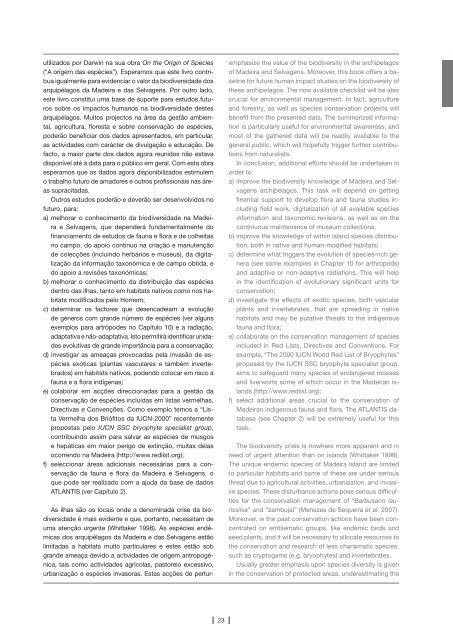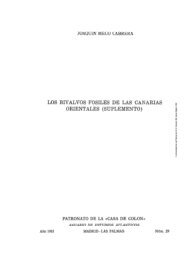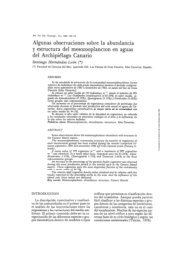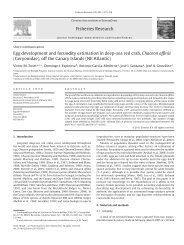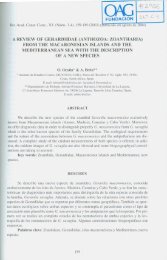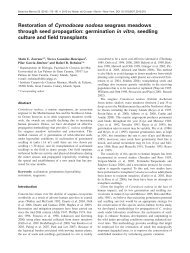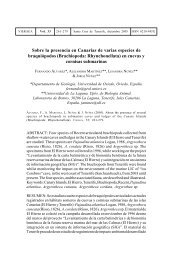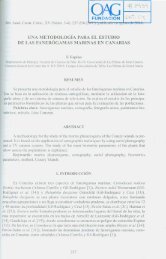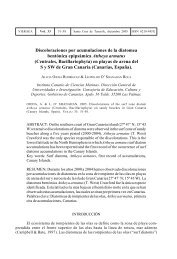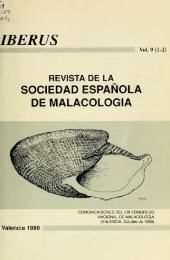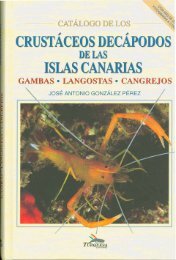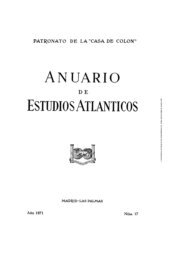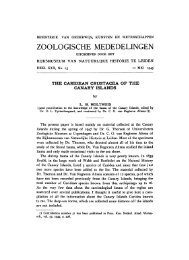of the madeira and selvagens archipelagos - redmic
of the madeira and selvagens archipelagos - redmic
of the madeira and selvagens archipelagos - redmic
You also want an ePaper? Increase the reach of your titles
YUMPU automatically turns print PDFs into web optimized ePapers that Google loves.
utilizados por Darwin na sua obra On <strong>the</strong> Origin <strong>of</strong> Species<br />
(“A origem das espécies”). Esperamos que este livro contribua<br />
igualmente para evidenciar o valor da biodiversidade dos<br />
arquipélagos da Madeira e das Selvagens. Por outro lado,<br />
este livro constitui uma base de suporte para estudos futuros<br />
sobre os impactos humanos na biodiversidade destes<br />
arquipélagos. Muitos projectos na área da gestão ambiental,<br />
agricultura, floresta e sobre conservação de espécies,<br />
poderão beneficiar dos dados apresentados, em particular,<br />
as actividades com carácter de divulgação e educação. De<br />
facto, a maior parte dos dados agora reunidos não estava<br />
disponível até à data para o público em geral. Com esta obra<br />
esperamos que os dados agora disponibilizados estimulem<br />
o trabalho futuro de amadores e outros pr<strong>of</strong>issionais nas áreas<br />
supracitadas.<br />
Outros estudos poderão e deverão ser desenvolvidos no<br />
futuro, para:<br />
a) melhorar o conhecimento da biodiversidade na Madeira<br />
e Selvagens, que dependerá fundamentalmente do<br />
financiamento de estudos de fauna e flora e de colheitas<br />
no campo, do apoio contínuo na criação e manutenção<br />
de colecções (incluindo herbários e museus), da digitalização<br />
da informação taxonómica e de campo obtida, e<br />
do apoio a revisões taxonómicas;<br />
b) melhorar o conhecimento da distribuição das espécies<br />
dentro das ilhas, tanto em habitats nativos como nos habitats<br />
modificados pelo Homem;<br />
c) determinar os factores que desencadeiam a evolução<br />
de géneros com gr<strong>and</strong>e número de espécies (ver alguns<br />
exemplos para artrópodes no Capítulo 10) e a radiação,<br />
adaptativa e não -adaptativa. Isto permitirá identificar unidades<br />
evolutivas de gr<strong>and</strong>e importância para a conservação;<br />
d) investigar as ameaças provocadas pela invasão de espécies<br />
exóticas (plantas vasculares e também invertebrados)<br />
em habitats nativos, podendo colocar em risco a<br />
fauna e a flora indígenas;<br />
e) colaborar em acções direccionadas para a gestão da<br />
conservação de espécies incluídas em listas vermelhas,<br />
Directivas e Convenções. Como exemplo temos a “Lista<br />
Vermelha dos Briófitos da IUCN -2000” recentemente<br />
propostas pelo IUCN SSC bryophyte specialist group,<br />
contribuindo assim para salvar as espécies de musgos<br />
e hepáticas em maior perigo de extinção, muitas delas<br />
ocorrendo na Madeira (http://www.redlist.org);<br />
f) seleccionar áreas adicionais necessárias para a conservação<br />
da fauna e flora da Madeira e Selvagens, o<br />
que pode ser realizado com a ajuda da base de dados<br />
ATLANTIS (ver Capítulo 2).<br />
As ilhas são os locais onde a denominada crise da biodiversidade<br />
é mais evidente e que, portanto, necessitam de<br />
uma atenção urgente (Whittaker 1998). As espécies endémicas<br />
dos arquipélagos da Madeira e das Selvagens estão<br />
limitadas a habitats muito particulares e estes estão sob<br />
gr<strong>and</strong>e ameaça devido a actividades de origem antropogénica,<br />
tais como actividades agrícolas, pastoreio excessivo,<br />
urbanização e espécies invasoras. Estas acções de pertur-<br />
23<br />
emphasize <strong>the</strong> value <strong>of</strong> <strong>the</strong> biodiversity in <strong>the</strong> <strong>archipelagos</strong><br />
<strong>of</strong> Madeira <strong>and</strong> Selvagens. Moreover, this book <strong>of</strong>fers a baseline<br />
for future human impact studies on <strong>the</strong> biodiversity <strong>of</strong><br />
<strong>the</strong>se <strong>archipelagos</strong>. The now available checklist will be also<br />
crucial for environmental management. In fact, agriculture<br />
<strong>and</strong> forestry, as well as species conservation projects will<br />
benefit from <strong>the</strong> presented data. The summarized information<br />
is particularly useful for environmental awareness, <strong>and</strong><br />
most <strong>of</strong> <strong>the</strong> ga<strong>the</strong>red data will be readily available to <strong>the</strong><br />
general public, which will hopefully trigger fur<strong>the</strong>r contributions<br />
from naturalists.<br />
In conclusion, additional efforts should be undertaken in<br />
order to:<br />
a) improve <strong>the</strong> biodiversity knowledge <strong>of</strong> Madeira <strong>and</strong> Selvagens<br />
<strong>archipelagos</strong>. This task will depend on getting<br />
finantial support to develop flora <strong>and</strong> fauna studies including<br />
field work, digitalization <strong>of</strong> all available species<br />
information <strong>and</strong> taxonomic revisions, as well as on <strong>the</strong><br />
continuous maintenance <strong>of</strong> museum collections;<br />
b) improve <strong>the</strong> knowledge <strong>of</strong> within isl<strong>and</strong> species distribution,<br />
both in native <strong>and</strong> human -modified habitats;<br />
c) determine what triggers <strong>the</strong> evolution <strong>of</strong> species -rich genera<br />
(see some examples in Chapter 10 for arthropods)<br />
<strong>and</strong> adaptive or non -adaptive radiations. This will help<br />
in <strong>the</strong> identification <strong>of</strong> evolutionary significant units for<br />
conservation;<br />
d) investigate <strong>the</strong> effects <strong>of</strong> exotic species, both vascular<br />
plants <strong>and</strong> invertebrates, that are spreading in native<br />
habitats <strong>and</strong> may be putative threats to <strong>the</strong> indigenous<br />
fauna <strong>and</strong> flora;<br />
e) collaborate on <strong>the</strong> conservation management <strong>of</strong> species<br />
included in Red Lists, Directives <strong>and</strong> Conventions. For<br />
example, “The 2000 IUCN World Red List <strong>of</strong> Bryophytes”<br />
proposed by <strong>the</strong> IUCN SSC bryophyte specialist group,<br />
aims to safeguard many species <strong>of</strong> endangered mosses<br />
<strong>and</strong> liverworts some <strong>of</strong> which occur in <strong>the</strong> Madeiran isl<strong>and</strong>s<br />
(http://www.redlist.org);<br />
f) select additional areas crucial to <strong>the</strong> conservation <strong>of</strong><br />
Madeiran indigenous fauna <strong>and</strong> flora. The ATLANTIS database<br />
(see Chapter 2) will be extremely useful for this<br />
task.<br />
The biodiversity crisis is nowhere more apparent <strong>and</strong> in<br />
need <strong>of</strong> urgent attention than on isl<strong>and</strong>s (Whittaker 1998).<br />
The unique endemic species <strong>of</strong> Madeira Isl<strong>and</strong> are limited<br />
to particular habitats <strong>and</strong> some <strong>of</strong> <strong>the</strong>se are under serious<br />
threat due to agricultural activities, urbanization, <strong>and</strong> invasive<br />
species. These disturbance actions pose serious difficulties<br />
for <strong>the</strong> conservation management <strong>of</strong> “Barbusano laurissilva”<br />
<strong>and</strong> “zambujal” (Menezes de Sequeira et al. 2007).<br />
Moreover, in <strong>the</strong> past conservation actions have been concentrated<br />
on emblematic groups, like endemic birds <strong>and</strong><br />
seed plants, <strong>and</strong> it will be necessary to allocate resources to<br />
<strong>the</strong> conservation <strong>and</strong> research <strong>of</strong> less charismatic species,<br />
such as cryptogams (e.g. bryophytes) <strong>and</strong> invertebrates.<br />
Usually greater emphasis upon species diversity is given<br />
in <strong>the</strong> conservation <strong>of</strong> protected areas, underestimating <strong>the</strong>


